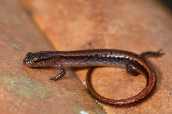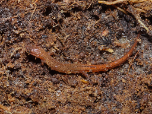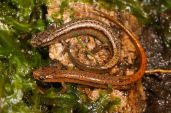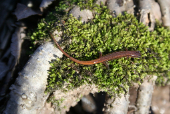Hillis's Dwarf Salamander (Eurycea hillisi)
Description: A very small, to 2.8 inches, slender terrestrial salamander with only four toes on the hind foot, 14 costal grooves, and no constriction at the base of the tail, which is round in cross-section and lacks a keel. Dorsal coloration copper, bronze, or orangish-brown, and ranging from patternless to boldly marked with a herring bone pattern; dorsolateral stripe brown and of variable intensity, with irregular edges, and usually most prominent on posterior half of body and tail. Grayish to white flecking common on head and adjacent to dorsolateral stripe. Ventral surface of head gray to white, which extends onto body. Underside of tail and groin yellow, which usually extends anteriorly to include most of the ventral surface. Cirri (a pair of fleshy protruberances below the nostrils) present in males during breeding season.
Habitat: A wetland species associated with seepage along swampy stream systems typically with hardwood canopies of black gum, cypress, and sweetbay magnolia; adults are usually found in association with sphagnum moss. Eggs are laid in water and develop into gilled larvae that presumably remain aquatic for only a few months before metamorphosing and moving to slightly more terrestrial though still damp microhabitats for adult life.
Range: This species occurs in southern Alabama, with the exception of the Mobile Bay area, south to the Florida panhandle, and east to mid-central Georgia. It could occur further west, more widely in eastern Georgia, and possibly into South Carolina, but further surveys are needed to confirm this.
Found in these States:
AL |
FL |
GA
Diet: species primarily consume small invertebrates.
Reproduction: Eggs are laid in water and develop into gilled larvae that presumably remain aquatic for only a few months before metamorphosing and moving to slightly more terrestrial though still damp microhabitats for adult life. Gravid females have been found in March, suggesting nesting likely takes place in March and April. Newly metamorphosed juvenile Hillis' dwarf salamanders appear in June.
Status: Listed as Least Concern in view of its wide distribution, presumed large population, and because it is unlikely to be declining fast enough to qualify for listing in a more threatened category.
Taxonomy: It was previously thought to be a population of the southeastern dwarf salamander (E. quadridigitata) but a 2017 study found it to be a distinct species based on genetic evidence, and described it as E. hillisi. It is named in honor of American evolutionary biologist David Hillis. It is unlikely that any previous studies had analyzed populations of this species.
»» Kingdom: Animalia - Animals
»» Phylum: Chordata - Chordates
»» Subphylum: Vertebrata - Vertebrates
»» Class: Amphibia - (Amphibians)
»» Order: Caudata - Salamanders
»» Family: Plethodontidae - Lungless Salamanders
»» Genus: Eurycea
»» Species: Eurycea hillisi - Hillis' Dwarf Salamander
This article uses material from the Wikipedia article "Hillis' Dwarf Salamander", which is released under the Creative Commons Attribution-Share-Alike License 3.0. Content may have been omitted from the original, but no content has been changed or extended.
|













